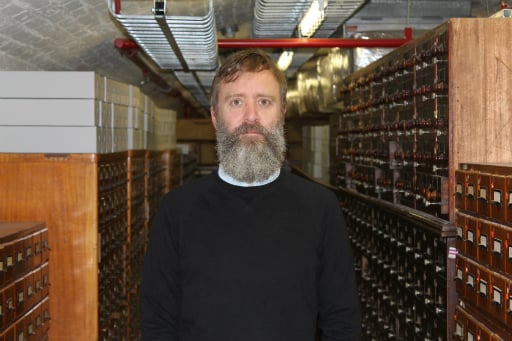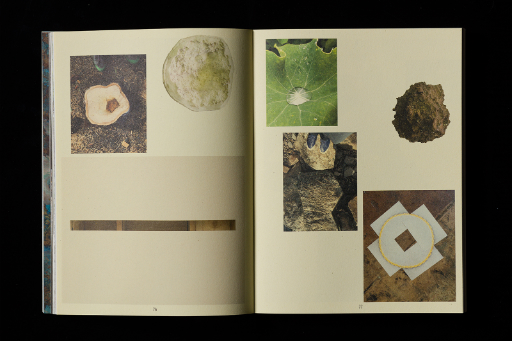Adam Cruickshank
True Belief

Adam Cruickshank, 2017
.
Everything Far Away Can Be Near Again, 2014
.
The Half-Asleep Pilgrim, Melbourne, 2013
.
In One Hundred Thousand Yearsw, 2017
.Introduction
My name is Adam Cruickshank. I am an artist and graphic designer. I live in Melbourne and I run a small publishing imprint called True Belief, the latest book from which is called In One Hundred Thousand Yearsw, which is a kind of artist's monograph about the Melbourne-based artist collective, Open Spatial Workshop.
Next up: What's your definition of an artist book?What's your definition of an artist book?
It's really difficult to define an artist's book. I think there's been so many historical precedences that fit into the category that it's very difficult to kind of specify what they as a whole group might be.
I know with the artist's books that I make, they're generally about books to a certain degree, and they use my history in graphic design to be produced, but the subject and the material is sort of approached from a more artistic viewpoint.
I think artist's books buck convention. And I think books are one of those parts of culture that are sort of very steeped in convention, because we've been using them for such a long time, and so successfully. I mean, those conventions work really well, that's why they're conventions, I guess.
Next up: Tell us about your imprint, True Belief.Tell us about your imprint, True Belief.
True Belief is really a small publishing imprint. Essentially, it's me buying a bunch of ISBN numbers a number of years ago. And I'd already done a number of publications – usually they were publications that were associated with exhibitions that I was doing – and I wasn't really keeping track of them. They weren't being properly archived or anything, so at some point I put the words 'true belief' in the back of one of them, as a kind of pretend publishing company that didn't really exist or anything.
And subsequently, everything that I've done that's been a publication has been under that imprint. But there's a good – I'm not quite sure how many, maybe six or seven ones previous to that, that now don't get included in that umbrella.
Next up: How do you use the artist book format to keep a record of your exhibitions?How do you use the artist book format to keep a record of your exhibitions?
One of the main concerns that True Belief has is this idea that publications are what really preserve exhibitions. We often think that exhibitions make their way into the archive and we can refer to them in subsequent years, but it's not really [true]. The exhibitions never do that; it's always the objects of graphic design that do it for them, so we have proxies in the archive for exhibitions rather than the actual exhibitions.
And I think that that seems quite an obvious point, but it's also interesting to note that the way graphic design does that and the kinds of publications that archive contemporary art practice, very strictly, in general, follow a set of kind of ways to work. And of course there's all kinds of other interesting things happening, but in general that's what happens – there's a very kind of strict set of conventions for artist's monographs and for exhibition catalogues and the like.
And I'm by no means unique, but I'd like to try and find new ways to do those things. And I think that trying to represent an exhibition that might have elements of kind of movement or processes that are happening in the gallery, representing that with sort of stills photography in a book isn't particularly accurate in many instances, so I'm trying to find slightly more expressive ways for books like that to work.
Next up: How does the design of an artist book differ from a commercial or traditional book?How does the design of an artist book differ from a commercial or traditional book?
So when I design an artist's book, I have very different criteria than when I'm designing a commercial book. Obviously, there are certain conventions that are important when you're designing a book that you expect lots of people to pick up and read, or that has to sell itself off a newsagent's shelf.
If I'm designing an artist's book – or making an artist's book might even be more appropriate – many of those conventions in graphic design such as 'don't use too many typefaces' (there are hundreds of rules that graphic designers pay attention to in order to create works that are readable and fit in the time and place in which they're made), and you don't have to pay attention to any of those, particularly if you're making an artist's book.
So really that's a driving goal, to try and find ways for books to work that they don't currently. And that sounds like it might be a bit of a big task in a way because books have been functioning, technological objects in our lives for so many hundreds of years, that we might have found ideal ways for them to work already. And I think we have but I don't think that it's impossible that we can find other ways for books to work.
And I'm not suggesting that I've done that, but it is a goal to try and find different ways for books to work. So traditional contents, or page numbers, or things that we usually use to navigate books are either ignored or replaced or changed in some way.
Next up: How do you use archives to organise content?How do you use archives to organise content?
I think The Half-Asleep Pilgrim and In One Hundred Thousand Yearsw, which is a book I made about Open Spatial Workshop, and a couple of the other ones as well, they very much approach an archive. They look at an area of knowledge and it's from within there that I'm allowed to take and manipulate content. And it's a way to kind of bound projects that are quite leaky, for want of a better term, so they can start spreading in all kinds of directions. And one of the ways to corral them is to use an archive, which is essentially just a library, a library of information.
I get excited when I see collections like that because the possibilities seem endless to me when you have an archive. Like looking at the State Library's various collections is a kind of – it puts me in a state of anticipation and excitement, I guess.
Next up: Tell us about your zine, Squash Nord.Tell us about your zine, Squash Nord.
Squash Nord is a very small little zine that I made with an ex-student of mine, Ned Shannon. I guess it's important for me to do things like that, that are quick and a bit off the cuff and sort of fun. There wasn't a lot of kind of intellectual working out of that project – it's a kind of typographic joke and we wanted to make something that basically got that joke out, made that joke public. And it's a sort of not-for-profit project in that there's a small fee for each copy, but as soon as we've paid off the print, that money goes to the Asylum Seekers Resource Centre.
Next speaker: Rob Jan